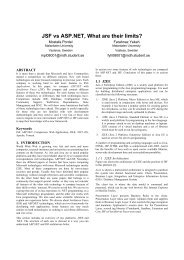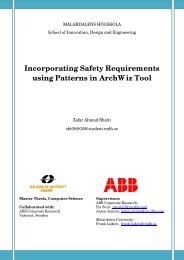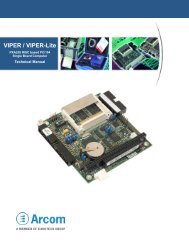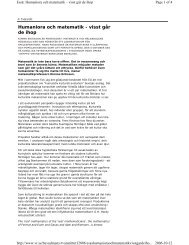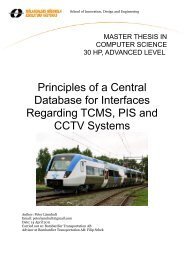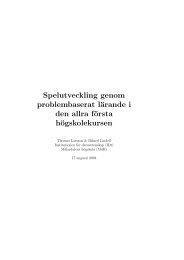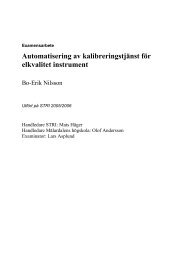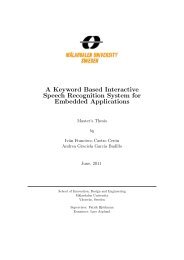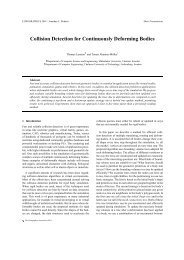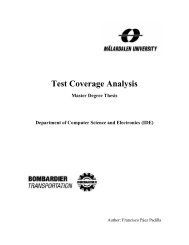Implementation of data collection tools using NetFlow for statistical ...
Implementation of data collection tools using NetFlow for statistical ...
Implementation of data collection tools using NetFlow for statistical ...
You also want an ePaper? Increase the reach of your titles
YUMPU automatically turns print PDFs into web optimized ePapers that Google loves.
4 <strong>Implementation</strong><br />
at is Munin [15], as it seem to updated regularly and is gaining traction in the community.<br />
However, the point was not to investigate if a certain graphing tool is better than another. The tool is<br />
just that; a tool about graphing collected <strong>data</strong> into an easy to read, comprehensible way. Both Cacti<br />
and MRTG accomplishes this.<br />
4.3 Solution<br />
The main purpose to use pmacct was as a helpful tool in mitigating DDoS attacks. Detecting them<br />
quickly would allow I2B to take appropriate action, such as blackholing the addresses itself (also<br />
known as a null route) as well as in<strong>for</strong>ming the ISP from where the attack originated. As mentioned,<br />
the faster they could identify the IP addresses the faster the threat would be contained.<br />
The first approach to avoid wrongful configuration which might end up disrupting customer traffic<br />
was to do everything in a virtual environment; <strong>using</strong> the free GNS3 framework which emulates<br />
routers from different brands, including Cisco and Juniper. This would emulate any number <strong>of</strong><br />
routers with the added advantage <strong>of</strong> not having to worry about configuration mistakes. Once the<br />
configuration and environment would be set up, it could either be migrated directly to the live<br />
routers since the configuration would be exactly the same, or even continue running virtually. GNS3<br />
supports bridged networking which allows <strong>for</strong> communication with the outside world, much like<br />
any OS virtualization s<strong>of</strong>tware like VMware or VirtualBox do. The idea was later discarded <strong>for</strong><br />
several reasons; it was felt that creating and configuring the virtual environment would be too timeconsuming<br />
considering what would be gained. Spending this time double-checking the<br />
configuration seemed like a better use <strong>of</strong> the already diminishing timetable.<br />
One other reason <strong>for</strong> not implementing a virtual environment was due to the fact that GNS3 requires<br />
a real operating system <strong>of</strong> the router it is emulating. Thus, emulating a Cisco Catalyst 6500 like the<br />
small router would require obtaining a Cisco IOS license <strong>for</strong> the 6500. Even if that was achieved,<br />
generating traffic to capture with <strong>NetFlow</strong> would take additional time to set up. It was however<br />
possible to use virtual machines with VMware or VirtualBox to create hosts and link that universe<br />
with GNS3 and its virtual routers. In essence, bridging two virtual environments together, either<br />
alone or connected to the real network as well. It was either that or yet another license would need<br />
to be obtained, this one <strong>for</strong> traffic generation (TGN <strong>for</strong> instance). The whole idea was discarded<br />
after a few days when the amounting time <strong>for</strong> configuration became apparent. It was then decided<br />
that a live environment would be used instead, with extra care given to the configuration. The<br />
problem actually solved itself when configuring Quagga, the s<strong>of</strong>tware router (see below).<br />
The Linux distribution used was Ubuntu Server 11.10 (Oneiric) 64 bit with 8 GB RAM and 4 CPU<br />
cores (1 physical).<br />
4.3.1 Collecting the <strong>data</strong> - solution<br />
In order to collect the desired <strong>data</strong> the small router was configured to send <strong>NetFlow</strong>-traffic to the<br />
Linux machine as well as configuration <strong>of</strong> the s<strong>of</strong>tware router, Quagga, to send BGP in<strong>for</strong>mation.<br />
See appendix 8.3 and 8.4 <strong>for</strong> configuration.<br />
30



